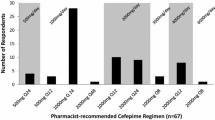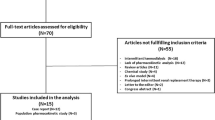Abstract
Background Patients requiring SLED are often critically ill and/or hemodynamically unstable, and often need antibiotic therapy for life-threatening infections. Antibiotic dosing recommendations for intermittent hemodialysis and continuous renal replacement therapy are not appropriate for SLED and there is substantial concern for under dosing. Objective To characterize the adequacy of antibiotic dosing during SLED. Setting: Inpatient adult acute care hospital. Methods A retrospective chart review was performed for the period of October 2010 to August 2013 to identify patients who received SLED and at least one of the selected antibiotics: cefepime, daptomycin, piperacillin/tazobactam, meropenem, and vancomycin. Dosing regimens were evaluated each day the patient was receiving one of these antibiotics concurrently with SLED. The administered antibiotic dosing regimens were defined as “adequate” or “inadequate” based on recommendations available in the literature. Main outcome measure The percentage of adequate antibiotic days for each antibiotic. Results Antibiotic regimens were evaluated for a total of 51 patients: 35 (69%) with acute kidney injury, 16 (31%) with end-stage renal disease, mean SLED duration 9.3 ± 1.7 h. The total percent of adequate antibiotic days were: vancomycin 86%, cefepime 62%, daptomycin 58%, meropenem 35%, and piperacillin/tazobactam 20%. Under dosing accounted for 63% of the days antibiotic dosing was considered inadequate. Conclusion: Antibiotic dosing was frequently inadequate, especially for antibiotics requiring more frequent dosing, suggesting a high potential for subtherapeutic levels during the majority of time critically ill patients are requiring SLED.

Similar content being viewed by others
References
Kovacs B, Sullivan KJ, Hiremath S, Patel RV. Effect of sustained low efficient dialysis versus continuous renal replacement therapy on renal recovery after acute kidney injury in the intensive care unit: a systematic review and meta-analysis. Nephrology. 2017;22:343–53.
Nash DM, Przech S, Wald R, O’Reilly D. Systematic review and meta-analysis of renal replacement therapy modalities for acute kidney injury in the intensive care unit. J Crit Care. 2017;41:138–44.
Marshall MR, Golper TA. Low-efficiency acute renal replacement therapy: role in acute kidney injury. Semin Dial. 2011;24:142–8.
Marshall MR, Golper TA, Shaver MJ, Alam MG, Chatoth DK. Sustained low-efficiency dialysis for critically ill patients requiring renal replacement therapy. Kidney Int. 2001;60:777–85.
Jamal JA, Udy AA, Lipman J, Roberts JA. The impact of variation in renal replacement therapy settings on piperacillin, meropenem, and vancomycin drug clearance in the critically ill: an analysis of published literature and dosing regimens. Crit Care Med. 2014;42:1640–50.
Roberts DM, Liu X, Roberts JA, Nair P, Cole L, Roberts MS, et al. A multicenter study on the effect of continuous hemodiafiltration intensity on antibiotic pharmacokinetics. Crit Care. 2015;19:84.
Scoville BA, Mueller BA. Medication dosing in critically ill patients with acute kidney injury treated with renal replacement therapy. Am J Kidney Dis. 2013;61:490–500.
Bogard KN, Peterson NT, Plumb TJ, Erwin MW, Fuller PD, Olsen KM. Antibiotic dosing during sustained low-efficiency dialysis: special considerations in adult critically ill patients. Crit Care Med. 2011;39:560–70.
Harris LE, Reaves AB, Krauss AG, Griner J, Hudson JQ. Evaluation of antibiotic prescribing patterns in patients receiving sustained low-efficiency dialysis: opportunities for pharmacists. Int J Pharm Pract. 2013;21:55–61.
Mei JP, Ali-Moghaddam A, Mueller BA. Survey of pharmacists’ antibiotic dosing recommendations for sustained low-efficiency dialysis. Int J Clin Pharm. 2016;38:127–34.
Shaw AR, Chaijamorn W, Mueller BA. We underdose antibiotics in patients on CRRT. Semin Dial. 2016;29:278–80.
Shaw AR, Mueller BA. Antibiotic dosing in continuous renal replacement therapy. Adv Chronic Kidney Dis. 2017;24:219–27.
Nolin TD, Aronoff GR, Fissell WH, Jain L, Madabushi R, Reynolds K, et al. Pharmacokinetic assessment in patients receiving continuous RRT: perspectives from the Kidney Health Initiative. Clin J Am Soc Nephrol. 2015;10:159–64.
Jamal JA, Mueller BA, Choi GY, Lipman J, Roberts JA. How can we ensure effective antibiotic dosing in critically ill patients receiving different types of renal replacement therapy? Diagn Microbiol Infect Dis. 2015;82:92–103.
Lewis SJ, Kays MB, Mueller BA. Use of Monte Carlo simulations to determine optimal carbapenem dosing in critically ill patients receiving prolonged intermittent renal replacement therapy. J Clin Pharmacol. 2016;56:1277–87.
Gharibian KN, Mueller BA. Fluconazole dosing predictions in critically-ill patients receiving prolonged intermittent renal replacement therapy: a Monte Carlo simulation approach. Clin Nephrol. 2016;86:43–50.
Matzke GR, Aronoff GR, Atkinson AJ Jr, Bennett WM, Decker BS, Eckardt KU, et al. Drug dosing consideration in patients with acute and chronic kidney disease-a clinical update from Kidney Disease: improving Global Outcomes (KDIGO). Kidney Int. 2011;80:1122–37.
Sinnollareddy MG, Roberts MS, Lipman J, Peake SL, Roberts JA. Pharmacokinetics of piperacillin in critically ill patients with acute kidney injury receiving sustained low-efficiency diafiltration. J Antimicrob Chemother. 2018;73(6):1647–50.
Braune S, Konig C, Roberts JA, Nierhaus A, Steinmetz O, Baehr M, et al. Pharmacokinetics of meropenem in septic patients on sustained low-efficiency dialysis: a population pharmacokinetic study. Crit Care. 2018;22:25.
Acknowledgements
The authors would like to acknowledge the assistance of the Dr. Joyce Broyles at Methodist University Hospital for assistance with this project.
Funding
No financial support was provided for this study.
Author information
Authors and Affiliations
Corresponding author
Ethics declarations
Conflicts of interest
The authors have no conflicts of interest to report.
Rights and permissions
About this article
Cite this article
Keough, L.A., Krauss, A. & Hudson, J.Q. Inadequate antibiotic dosing in patients receiving sustained low efficiency dialysis. Int J Clin Pharm 40, 1250–1256 (2018). https://doi.org/10.1007/s11096-018-0697-6
Received:
Accepted:
Published:
Issue Date:
DOI: https://doi.org/10.1007/s11096-018-0697-6




